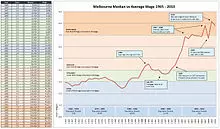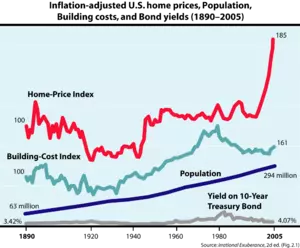The real estate market is no stranger to booms and busts. Periodically, local or even global real estate markets experience what is known as a real estate bubble, also referred to as a property bubble or a housing bubble in residential markets. These bubbles occur following a rapid increase in the market price of real property, such as housing, until they reach unsustainable levels and then decline.
The phenomenon of real estate bubbles is a subject of great interest and debate among economists. There are differing views on the identification and prevention of these bubbles and their broader macroeconomic significance. Bubbles in housing markets have historically proven to be more critical than stock market bubbles. They occur less frequently but last longer and have larger economic consequences.
 Image: US house price trend (1998-2008) as measured by the Case-Shiller index
Image: US house price trend (1998-2008) as measured by the Case-Shiller index
Identifying and preventing real estate bubbles can be challenging. The intrinsic value of real estate is often difficult to discern, making it hard to predict future bubbles accurately. However, various indicators and ratios can be used to evaluate whether homes in a given area are fairly valued and whether a bubble is forming.
 Image: Ratio of Melbourne median house prices to Australian annual wages, 1965 to 2010
Image: Ratio of Melbourne median house prices to Australian annual wages, 1965 to 2010
One such indicator is the price-to-income ratio, which compares median house prices to median familial disposable incomes. Another indicator is the price-rent ratio, which assesses the average cost of ownership divided by the received rent income or estimated rent. These indicators help economists gauge the affordability of housing and identify potential bubbles.
 Image: Inflation-adjusted home prices in Japan (1980-2005) compared to home price appreciation in the United States, Britain, and Australia (1995-2005)
Image: Inflation-adjusted home prices in Japan (1980-2005) compared to home price appreciation in the United States, Britain, and Australia (1995-2005)
The consequences of real estate bubbles can be severe. The bursting of these bubbles in various countries during the 2000s contributed to the financial crisis of 2007-2008. It led to a significant economic downturn and highlighted the interconnectedness of real estate markets with the broader economy.
Bubbles in real estate markets are not only a concern for economists but also for individuals and governments. Governments and central banks have a role to play in preventing bubbles from forming or deflating existing bubbles. Measures such as land value taxes can discourage speculation on land and make more land available for productive uses.
 Image: UK house prices between 1975 and 2006, adjusted for inflation
Image: UK house prices between 1975 and 2006, adjusted for inflation
The macroeconomic significance of real estate bubbles is a topic of debate among economists. While some consider them of critical importance and a fundamental cause of financial and economic crises, others downplay their significance. The impact of housing price increases on consumption and debt levels are factors that shape these differing perspectives.
As with any investment, real estate markets carry risks. Investors and potential buyers must be aware of the possibility of bubbles and exercise caution. It is essential to consider market fundamentals and indicators when making decisions in the real estate market.
 Image: Robert Shiller's plot of U.S. home prices, population, building costs, and bond yields, from Irrational Exuberance, 2d ed.
Image: Robert Shiller's plot of U.S. home prices, population, building costs, and bond yields, from Irrational Exuberance, 2d ed.
In conclusion, real estate bubbles are a recurrent phenomenon in the world of property markets. They pose both opportunities and risks for investors and individuals alike. Understanding the indicators and factors that contribute to these bubbles can help navigate the complex landscape of real estate investment and promote stability in the market.

















